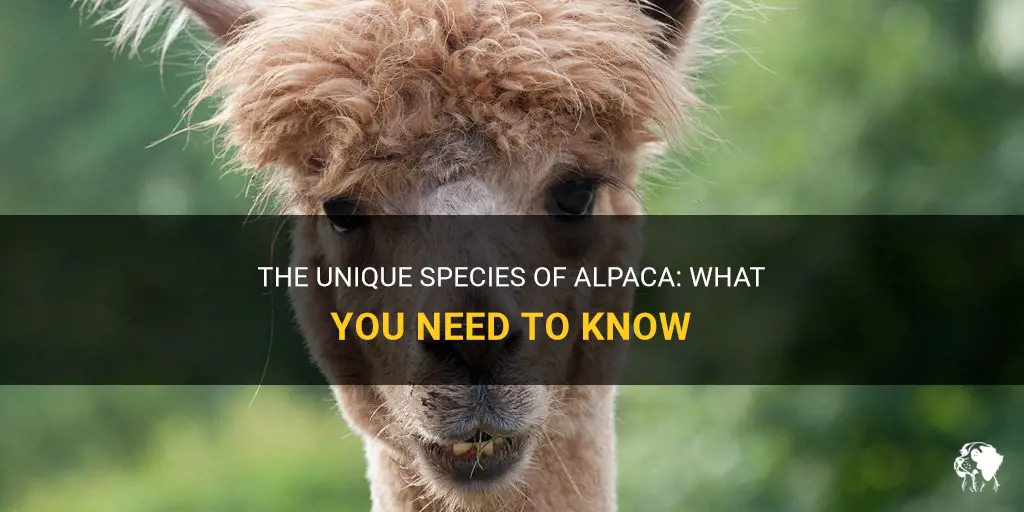
Alpacas, known as the gentle and charismatic inhabitants of the Andean mountains, are a unique species of domesticated camelid. Originating from South America, these fluffy and lovable creatures have captured the hearts of people around the world with their endearing appearance and gentle nature. With their long, luxurious wool and distinctive expressions, alpacas have become not only a popular symbol of the Andean culture but also a sought-after livestock for their valuable fiber. Let's delve into the world of alpacas and unravel the fascinating characteristics that make them truly one-of-a-kind.
| Characteristics | Values |
|---|---|
| Kingdom | Animal |
| Phylum | Chordata |
| Class | Mammalia |
| Order | Artiodactyla |
| Family | Camelidae |
| Genus | Vicugna |
| Species | V. pacos |
What You'll Learn

What species does the alpaca belong to?
The alpaca belongs to the Camelidae family, which includes other camelid species such as camels, llamas, and guanacos. Alpacas are native to South America, particularly the Andes Mountains, where they have been domesticated and raised for their wool for thousands of years.
Scientifically known as Vicugna pacos, alpacas are closely related to llamas but have distinctive differences in terms of size and fiber quality. Alpacas are smaller and more delicate than llamas, with a height of around 3 feet at the shoulder and weighing between 100 and 200 pounds. They have a slender body and a long, elegant neck.
One of the key features of alpacas is their luxurious fiber, which comes in two main types - huacaya and suri. Huacaya fiber is the most common type and is characterized by its dense, crimped appearance, similar to sheep's wool. Suri fiber, on the other hand, is long, straight, and silky, creating a flowing, lustrous effect.
Alpacas are known for their gentle and docile nature, making them easy to handle and care for. They are social animals and prefer to live in herds, which helps them feel safe and secure. Alpacas communicate with each other through various vocalizations, body postures, and facial expressions.
In terms of diet, alpacas are herbivores and primarily graze on grass and hay. They have a unique digestive system that allows them to efficiently extract nutrients from plant material. Alpacas are also ruminants, which means they have a multi-chambered stomach that enables them to ferment and break down fiber-rich food.
Alpacas are an environmentally-friendly livestock option, as they have a soft impact on the land. They have padded feet, which prevent them from causing soil erosion, and their grazing habits help control weeds and promote healthy pasture growth.
Alpacas are not only valuable for their fiber but also their calm and curious personalities. Many people enjoy keeping alpacas as pets or for their therapeutic presence. They can be trained to be halter-led, participate in shows, and even provide therapy to individuals with special needs.
In conclusion, the alpaca belongs to the Camelidae family and is a domesticated species native to South America. They are known for their luxurious fiber, gentle nature, and unique digestive system. Whether used for their wool or as companion animals, alpacas are fascinating creatures that bring joy to those who encounter them.
The Origins of Alpacas: Tracing Their Ancestry and Native Land
You may want to see also

Is the alpaca a member of the camel family?
The alpaca is a fascinating animal that is often mistaken for a member of the camel family. However, despite their similar appearance, alpacas are not actually a part of the camel family. Instead, they belong to the family Camelidae, which also includes camels, llamas, and guanacos. Let's explore the reasons why alpacas are not considered a member of the camel family.
Scientifically speaking, the main reason why alpacas are classified differently from camels is due to their genetic makeup and evolutionary history. While camels and alpacas share a common ancestor, they have since diverged and developed unique traits. DNA analysis has shown that alpacas and camels belong to separate subfamilies within the Camelidae family. Camels belong to the subfamily Camelinae, while alpacas belong to the subfamily Lamini. This genetic distinction is a primary factor in how animals are classified.
Furthermore, alpacas and camels have different physical characteristics that further differentiate them. Camels are known for their distinctive humps, which serve as a storage site for fat and can help them survive in arid environments. Alpacas, on the other hand, lack prominent humps and have a more compact body structure. They are well-adapted to the high-altitude environments of the Andes Mountains, where they originate from.
Another key difference between alpacas and camels is their domestication history and geographical distribution. Alpacas were domesticated by the indigenous peoples of the Andes region in South America thousands of years ago. They have been selectively bred for their fine wool and gentle temperament. Camels, on the other hand, have been domesticated in the Middle East and have been used for transportation and as a source of milk and meat. Camels are commonly found in arid regions such as the Sahara desert and are well-adapted to harsh desert conditions.
In terms of behavior, alpacas and camels also exhibit some differences. Alpacas are known for their gentle and docile nature, making them popular as companion animals and for their fiber production. They are not typically used as working animals and are often kept in herds for their social interactions. Camels, on the other hand, are used as pack animals and can carry heavy loads over long distances. They have a reputation for being able to endure harsh conditions and are well-suited for desert travel.
While alpacas and camels do share some similarities in terms of their appearance, such as long necks and large eyes, it is important to understand the distinctions that place them in separate categories. Their genetic makeup, physical characteristics, domestication history, and behavior all contribute to their classification within the larger Camelidae family.
In conclusion, while the alpaca may bear a resemblance to its camel relatives, it is not a member of the camel family. Instead, alpacas belong to the subfamily Lamini within the Camelidae family. Their genetic makeup, physical characteristics, domestication history, and behavior all set them apart from camels. Understanding these distinctions is crucial for appreciating the unique qualities of alpacas and their place within the animal kingdom.
The Global Population of Llamas: Unveiling the Enigmatic Count
You may want to see also

Are alpacas closely related to llamas?
Yes, alpacas and llamas are closely related as they both belong to the Camelidae family, which also includes camels. However, they are different species and have distinct characteristics.
Both alpacas and llamas are native to South America and have been domesticated for thousands of years. They were initially bred for their luxurious fiber, which is used to make high-quality clothing and textiles. While llamas were primarily used as pack animals, alpacas were selectively bred for their soft, dense, and fine fleece.
When comparing alpacas and llamas, there are a few key differences to consider. Firstly, llamas are generally larger than alpacas, standing at about 5.5 to 6 feet tall at the shoulder, whereas alpacas are smaller, measuring around 3 to 4 feet tall. Llamas also tend to be heavier, weighing between 280 to 450 pounds, while alpacas weigh around 100 to 200 pounds.
In terms of appearance, alpacas have a more rounded face with a shorter snout, while llamas have a longer face and a more pronounced nose. Llamas also have longer ears and a more upright posture compared to the more relaxed and alert stance of alpacas.
Another important distinction is their behavior. Llamas are known for their protective instincts and are often used to guard livestock, such as sheep and goats, from predators. They are highly social animals and are often kept in herds. Alpacas, on the other hand, are more timid and can be easily startled. They are usually kept in smaller groups and are not typically used as guard animals.
In terms of their fleece, alpacas have a finer and softer coat compared to llamas. Alpaca fleece comes in a wide range of natural colors, including white, black, brown, and gray. Llama fleece, on the other hand, is coarser and often used for making rugs and other durable products.
While alpacas and llamas can interbreed, their offspring, known as huarizo, are typically infertile. This is due to the difference in their chromosome numbers, with alpacas having 36 chromosomes and llamas having 74 chromosomes.
In conclusion, alpacas and llamas are closely related as they both belong to the Camelidae family. However, they have distinct characteristics in terms of size, appearance, behavior, and fiber quality. Despite their differences, both alpacas and llamas are fascinating animals that have been valued by humans for their unique qualities for centuries.
Creative Ideas for Making the Most of Your Llamas
You may want to see also

Is the alpaca a domesticated or wild species?
The alpaca is a domesticated species of camelid that is native to the Andean regions of South America, specifically Peru, Bolivia, and Chile. Domestication of the alpaca dates back thousands of years, with evidence of their presence being found in archaeological sites from as early as 4500 BCE.
Unlike their wild counterparts, the vicuña and guanaco, alpacas have been selectively bred by humans for their wool, making them a highly valued and important part of the textile industry. Alpacas are known for their luxurious and soft fleece, which comes in a variety of natural colors, including white, black, brown, and shades of gray.
One of the main characteristics that distinguishes the alpaca from its wild relatives is its docile and friendly temperament. Alpacas are known for being calm and gentle animals, making them ideal for domestication and raising in captivity. This domestication process has resulted in a close bond between humans and alpacas, with many farmers considering their alpacas as part of their family.
In terms of physical appearance, alpacas are smaller in size compared to their wild relatives. They have a stocky build, with a height of around 3 feet at the shoulder and a weight ranging from 100 to 200 pounds. Alpacas have long necks and legs, along with a short tail and a small head with large, expressive eyes. Their fur is dense and soft, providing excellent insulation against the harsh Andean climate.
Alpacas are herbivores, feeding mainly on grasses and other vegetation. They have a unique digestive system that allows them to extract maximum nutrients from their food. Alpacas are also known for their efficient use of water, requiring relatively little compared to other domesticated livestock.
Due to their domestication and close interaction with humans, alpacas have developed a strong sense of community and social hierarchy within their herds. They are highly social animals and are often raised in groups, with strong bonds formed between individuals. Alpacas communicate with each other through a variety of vocalizations and body language, allowing them to express their needs and emotions.
In conclusion, the alpaca is a domesticated species that has been selectively bred for thousands of years for its valuable wool. Unlike its wild relatives, the alpaca has a docile temperament, making it highly suitable for domestication. Its smaller size, soft fur, and efficient use of resources make it an ideal livestock animal for the Andean regions of South America. With their strong social bonds and close relationship with humans, alpacas have become an integral part of many farming communities and the textile industry.
The Alpaca and Llama: Are They the Same Thing?
You may want to see also

Are there different varieties or breeds of alpacas?
When it comes to alpacas, many people assume that there is only one type or breed. However, this is far from the truth. Alpacas actually come in a variety of breeds or varieties, each with its own unique characteristics and qualities. In this article, we will explore the different varieties of alpacas and what sets them apart from one another.
One of the most common breeds of alpacas is the Huacaya. This breed is known for its dense, fluffy fleece that has a crimped texture. The Huacaya alpaca has a robust and sturdy body, making it popular among breeders and farmers. They are prized for their soft and luxurious fiber that is used to make high-quality garments.
Another well-known breed of alpaca is the Suri. Unlike the Huacaya, Suri alpacas have long, silky locks that hang down from their bodies. This unique fiber is highly sought after in the textile industry, as it can be spun into lustrous yarns and fabrics. Suri alpacas have a slender build and are known for their elegant appearance.
In addition to these two main breeds, there are also several other varieties of alpacas that are less common but equally fascinating. The Vicuña is one such variety. This breed is extremely rare and is known for producing the finest fiber in the world. Vicuñas are smaller than other alpacas and have a delicate physique. Their luxurious fiber is highly prized and is used to make exclusive and expensive garments.
The Uakari is another unique variety of alpaca. It is distinguished by its red or pink facial coloring, which is caused by an abundance of blood vessels near the surface of the skin. This gives the Uakari a distinct and striking appearance. While their fiber is not as sought after as that of the Huacaya or Suri, Uakari alpacas are still valued for their individuality and beauty.
Overall, the different varieties and breeds of alpacas offer a wide range of characteristics and fiber types. Each breed has its own distinct qualities and is valued for specific purposes. Whether you are looking for fine fiber or a sturdy build, there is an alpaca breed for every need.
In conclusion, alpacas come in a variety of breeds or varieties, each with its own unique characteristics and qualities. The Huacaya and Suri are the most well-known breeds, with their distinct fiber types and appearances. However, there are also rarer varieties such as the Vicuña and Uakari, each with their own special attributes. Whether you are a breeder, farmer, or textile enthusiast, exploring the different varieties of alpacas can be a fascinating and rewarding experience.
The Hoofed Mysteries of Llamas Unveiled
You may want to see also







